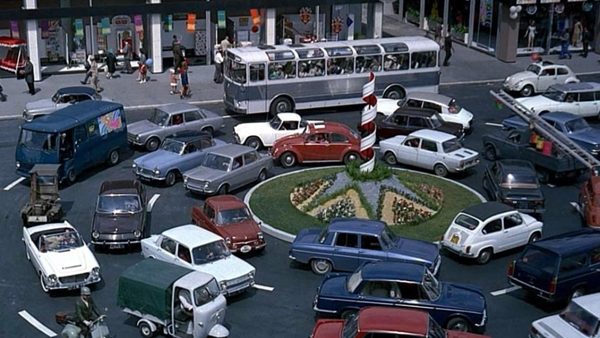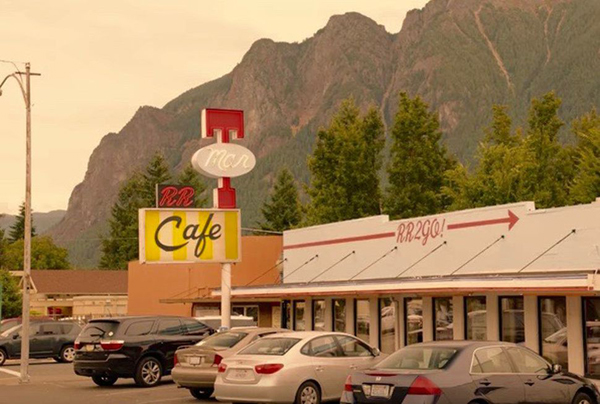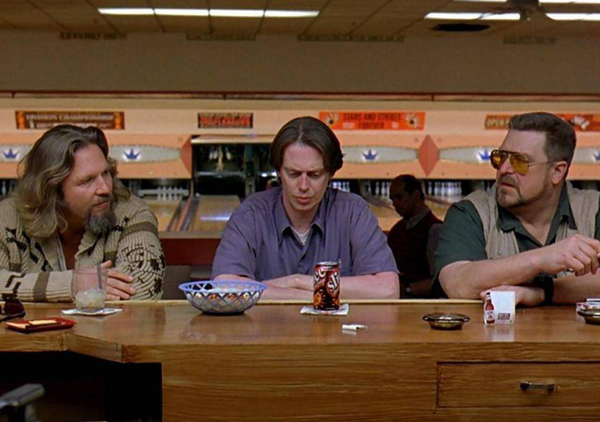 Beautiful Nothingness
Beautiful Nothingness
The Advent of Muzak Part 2
published in The Wire No.173, July, 1998, LondonWhen a lover whispers sweet nothings into another's ear, what is being stated? When the singer's voice can emote while singing trivial lyrics, what is being said? When a one-finger melody sends people into rapture, what is being communicated? Modes of musicalization from the lyrical to the timbrel abound with aural complexity in the po-faced spectrum of understatement, vacuousness, mundanity, dumbness.
Film music is generally deaf to the power of beautiful nothingness - of music's potency in reduction, of its force when cast in slight stature. Film music is brassy, sassy, classy. It either foists its mass upon our audio consciousness to suggest quality and production value, or its recourse to the sotto vocce (a single wandering pan pipe, the sole shimmering breath of a pubescent girl) effects a similar bombast. Finally - and continually - film music generates musical nothingness through its mimicry of itself, performing caricatures of its own aural images and tonal gestures in a grotesquery once expects from the drag queen's performance. The drag effect, though, exists by default: film music is desperate to be active, promotional, performative. It is there to assure you that it is doing its job. It feels it has to signify, communicate, organize narrational data for the ear. In its own way, film music then whispers sweet nothings to us through its drenched and saturated expression: its excessiveness amounts to the blandly articulated presence of that which we expect to be 'film music'. Hence the strong reactions against any music which does not perform in this way.
Muzak - the most carefully crafted inversion of music's sweet nothings - occupies a peculiar place in the terrain of film music. Its self-conscious presence is marked in occasional moments in early 70s counter-culture films (Robert Altman's oeuvre returns to this sardonic motif often). De-vocalised music softly plays in an elevator, waiting room or restaurant as a sign of middle class America's self-sanitation and anaesthetisation. The music is coded as a form of socio-political somnambulism. The point is as obvious as a Rolling Stone editorial; the effect is equally cheap. To this day, muzak is similarly employed as critique (even in fairly recent MTV promos as a gag) - even though such social spaces have not used lush 50s-style muzak or squaresville cover versions for over two decades. These days, Kenny G, Vivaldi, Mariah Carey, Deep Forest, the score to BETTY BLUE are more likely heard. Music that has clear identity, purpose, status; music not designed to erase its presence within your consciousness, but to fuse its dimensional beauty with your own mindscaped lifestyle.
The earliest and most astute inversion of muzak's numbing self-erasure is to be found in the colour films of Jacques Tati. Muzak - a mix of stock source music and composed frivolities - permeates MON ONCLE (1958), PLAYTIME (1967), TRAFFIC (1972) and PARADE (1974). Tati did not simply allude to the then-contemporaneous flavour of glitzy pseudo-jazzy cocktail combos: he depicted the social environs of such music. His scored moments are piped through the visible architecture of the urban design upon which Tati based his gags. Automation, urbanization, mechanisation are all ridiculed as bourgeois ideals, and the muzak which wafts out of offices, cafes and restaurants in Tati's films are the ambience of the disinfected city which urban design to this day snorts so salaciously. While films like FIVE EASY PIECES and THE GRADUATE frame muzak in opposition to the songs, icons or performances which trumpet the heroics of beat/hippie/college counter culture, Tati's films smother one with the oppressiveness of the finicky style-obsessed bourgeoisie and their mania for cosmetic altering of the social terrain. His films feature hardcore muzak by openly declaring the vapid aerated artiness that exists within that most suspect of aesthetic categories - the beautiful.
The 70s cinematic aesthetic of bludgeoning both ignorant and knowing forms of artificiality with the rubber mallets of 'realism' and 'naturalism' contributed to the mandate that film music be active in its statement, pro-active in its presentation and committed to is realization. Not suprisingly this has led to an ongoing 70s style aesthetic that feels comfortable with global/world eco-cliches of pan pipes, pygmy samples and libraries of exotic percussion purchasable from German CD companies. Muzak these days is conscious and conscionable; tasteful and tasty. Enya (airlines - comfort your patrons with this calming angel). The Gypsy Kings (spice up your restaurant with these heady musicians). Art cinema especially resembles the social domains from which these post/anti-muzak stylings emerge. In doing so, all critical distance evaporates, irony congeals, and the arty film score functions identical to the cheesy, queasy aural niceties which irritated Tati so many years ago.
It took the violently obvious postmodernism of David Lynch's TWIN PEAKS (1989) to make a clear statement on the preceding 20 years of collusions between empty beauty and the existentialism inherent in cosmeticized life-styles. Firstly, TWIN PEAKS engages in a deft historical revisionism. Americana in the cinema has often utilized the Southern and mid-Western states as retrogressive repositories of all that east coast intellectualism has abhorred for decades - particularly racism, xenophobia and insularism. Music scores of most social issue films since the 50s focused on a dialectic between the orchestral score and quotations of folk musics (from the blues to bluegrass) localized in the land mostly, from radio sometimes, on juke-boxes occasionally. Muzak - a non-folk industrialized fabrication which the listener consumes rather than identifies with - never appears in these scenarios. TWIN PEAKS is a PEYTON PLACE whose aural ambience of timber mills has been neutralized by the muzak of diners, clubs, hotels and casinos. No 'music of the local population' is evident; all has been replaced by a smothering somnambulistic softness. If muzak is the music of soulless machines, TWIN PEAKS posits people as a mix of the machinic, the mystical, the soulless, the sleepless. Secondly, TWIN PEAKS actively allows this blanket of aural repression to seep into the film score and replace it with what could be termed a 'possessed muzak': a score which is trapped into behaving like muzak while silencing its any overt or meta-textual mechanisms of character interiority and psychological inquiry.
There are few moments in TWIN PEAKS which sound like 'classic' muzak. If anything, Angelo Badalamenti's score is like a slowed-down rendering of Michael Mann's wilfully electronic soundscaping. Badalamenti's rockabilly reverb is highly digital; the strings are extremely electronic; the arrangements are archly modern in their Hermanesque lumbering of dark motifs; the blurred jazz intonations recall the early minimalist serialism of John Adams' AMERICAN STANDARD. But one figure anchors the main theme in the world of the beautiful: the 'water guitar' (sic) of Vinnie Bell. Since the 50s, Bell has recorded numerous 'light instrumental/pop' albums of evergreens and popular tunes of the times (from Caravan to Let The Sunshine In). A renowned experimenter with amplifiers, studio effects and tape manipulation (he was the first king of the double-speed guitar), one of Bell's inventions - the shimmering vibrato of the 'water guitar' - helped Ferrente and Teicher have a huge international hit with their cover version of the theme from AIRPORT (1970). The irony of known Easy Listening stars having a hit with Alfred Newman's last score inspired by muzak-airport lounge ambience certainly befits TWIN PEAKS' postmodern agenda. The sleepy death erotic of hearing heavenly music prior to you taking what might be your last flight has continued unabated since - through Eno's MUSIC FOR AIRPORTS (1978) at JFK to the angelic global soaring of X used in British Airway television ads. By TWIN PEAKS, there was nearly 20 years of beautiful music that was clearly coded with death: this will be the last sweetness you hear before you become nothing. The texture of Badalamenti's muzak-effects and Vinnie Bell's archaeology of waiting room music resonates strongly in TWIN PEAKS and accounts for much of the series' haunting and stilling qualities.
In the Coen's THE BIG LEBOWSKI (1998), contemporary muzak behaves similarly, but modulated by a penchant for abject blandness and the numbingly ugly. Like TWIN PEAKS, the production design is unerringly modern without resorting to camp. Many muzak moments shine: The Gypsy Kings' version of The Eagles' Hotel California plays in the bowling alley; Jeff Bridges pleads with an Afro-American cab driver to turn The Eagles off the radio; Bridges listens to whale songs on a shitty Walkman while he smokes joints in the bath; a trio of German thugs blast bad late-70s John Fox-style electro-angst-pop on a ghetto blaster; Esquivel bubbles as a bimbo paints her toe nails by the pool; Yuma Sumac plays at the beach party of a wealthy pornographer. Not all these moments are 'classically muzak' - but they each demonstrate how all forms of music can be emptied of value through production and consumption, rendering them as aural nothingness within which people find solace or terror.
The suburban mall pall of THE BIG LEBOWSKI echoes the Coen's excursions into stop-and-shop culture in RAISING ARIZONA (1985) and their most intense study of contemporary existentialism, FARGO (1996). Both feature sublime scenes of muzak-infected domains, but an oft-neglected aspect of the Coen's visual sterility is the counterpoint played by the hyper-eclectic scoring of Carter Burwell. FARGO demonstrates this vividly.
Against the film's opening white screen, a luridly evocative title theme swells and builds in volume, key modulation and orchestration. It feels Gaelic; it moves like a funeral march; it performs with a gypsy waywardness; it climbs in mythical scale. Its emotional content is the exact opposite of muzak, for where muzak signifies nothing by draining all recognizable dynamics into a muted referencing of a known tune, Burwell's score to FARGO accrues impossibly high dramatic levels of conflicting dramatics. Plus, the pure white screen gives zero cues as to how this music is to be read. In fact, it is not until the final scenes of the film that the score reveals its identity as a mellowed acceptance of the most extreme deviations of normality in the domestic realm. Rather than explicate the dysfunctionality of its many characters and the mind-destroying circumstances in which they sink or swim, FARGO opts for a rare acknowledgment that normality is neither an ideal nor an aspirant. It is merely a wafting veil like the snow of North Dakota. It falls on you; you sweep it away; you rug up against it; it often can look beautiful; it can make you lose your way. Burwell's scored moments - decisively few and critically selective - make a clear statement about beautiful nothingness through overscoring to create an alienating effect. In the end, the gorgeous orchestrations of his music are tempered by the abrasive existential veneer which created muzak in the first place. Muzak mumurs the nothingness of sweetness directly into your inner ear. Burwell's score to FARGO scares your aural consciousness with the realization that no amount of sweetness can cover the nothingness of everday life.
Text © Philip Brophy 1998. Images © respective copyright holders




